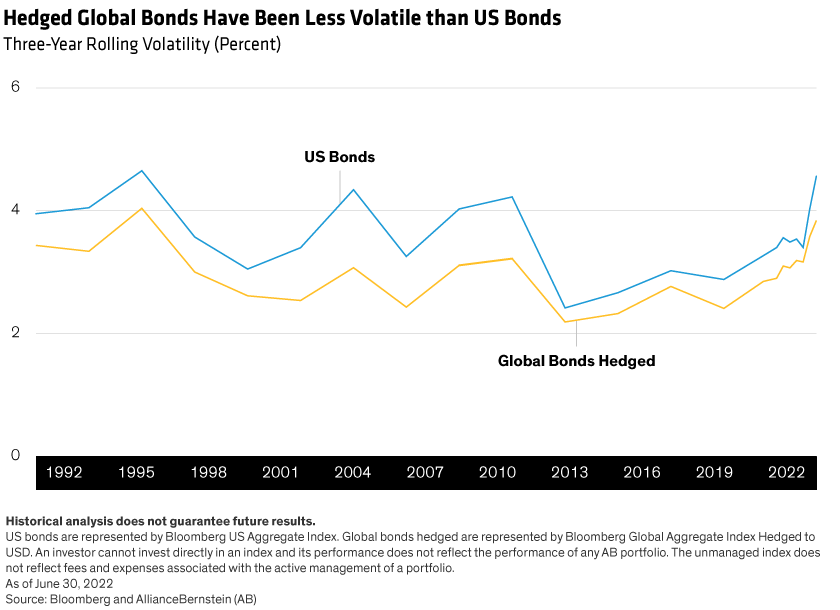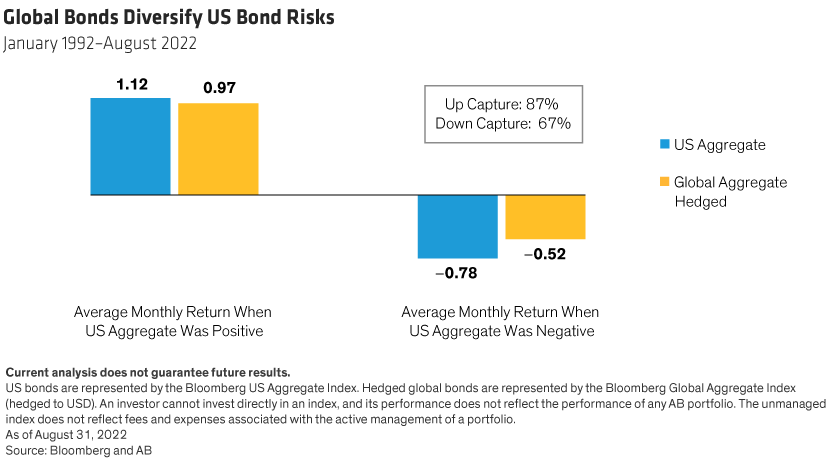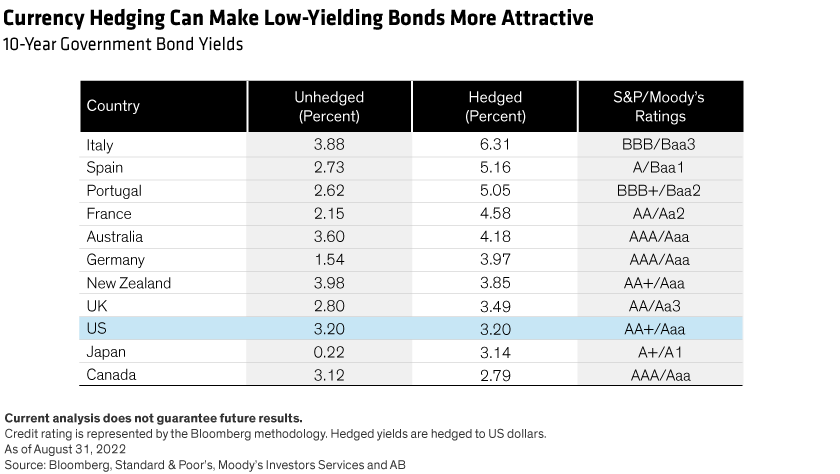Written by: Michael Rosborough, Nicholas Sanders and Ronit Walny
With inflation dominating the global landscape, asset-class diversification has been fleeting. It’s tempting for US investors to focus on their home-field yield advantage and forego opportunities abroad, but we believe that by expanding the fixed-income opportunity set globally, investors can capture some much-needed diversification, while still enjoying attractive yields.
Below are three key reasons why we think US investors should embrace the global bond market today.
1. Today’s diverging growth and policy scenarios widen global opportunities to add alpha.
Inflation is a global phenomenon. But, while the global outlook appears stormy, specific conditions and policy aggressiveness vary country by country. Central banks across the developed world differ in their ability to maneuver, their impact on local economies and their effectiveness in combatting inflation. The US Fed, for example, moved earlier and more aggressively than other central banks, having more maneuverability given its strong economic starting point.
In contrast, the EU inflation picture is bleaker. Energy prices are soaring, and inflation-fighting efforts are creating a much larger economic dent, making a recession almost inevitable. China continues to experience COVID-19 related disruptions, while Japan may unwind its yield-curve control policy. In Canada and Australia, where home mortgages roll every five years, policy response is more amplified than in the US, which has a 30-year loan standard.
Such diverging growth and inflation regimes create opportunities for investors to differentiate and add new sources of alpha.
For example, we like longer-term German Bunds. As the ECB accelerates its inflation fight, we expect it to drive the European economy into recession and flatten the yield curve further, with longer-maturity Bunds outperforming. Meanwhile, in Australia, the housing market is especially sensitive to rising interest rates due to the large number of floating-rate mortgages. So, we expect Australian government bonds to outperform others, including US Treasuries.
In contrast, we’re cautious on the UK market, where a large fiscal expansion to cap energy prices is likely to limit inflation’s impact on consumers’ purchasing power, keeping inflation aloft. The weakening pound also enhances inflation concerns for the Bank of England. Japan needs scrutiny as well, as diverging rates significantly weaken the yen and could pressure embedded caps on yields from its yield-curve control policy.
2. The global bond market is less volatile and supplies bigger diversification benefits than the US bond market—especially in today’s environment.
The global bond universe is much larger and more diverse than the US bond market. Not only does it offer more opportunities from which an active manager can choose, but its differing landscapes provide significant variety and diversification sources.
Bond returns differ greatly country by country and year to year because of varying economic cycles, monetary cycles, business cycles, inflation regimes, geopolitical concerns and yield curves. Today this is even more evident as countries like China pursue a more accommodative stance, while the UK is combatting very high inflation at the expense of long-term growth.
Sector returns also vary across countries and regions. For instance, manufacturers in the US are responding to a different environment than those in Europe, including labor availability and electricity costs and supply. More broadly, the deglobalization super trend makes it important to diversify regionally.
Historically, the hedged global bond market has generated higher returns with less volatility than the US bond market. For example, over the 30 years ending June 30, 2022, the Bloomberg Global Aggregate Index (hedged into US dollars) posted an average annualized return of 5.0%, versus 4.8% for the Bloomberg US Aggregate Index. And it did so with less volatility (Display). The divergence was even more acute this year, as the global bond market outperformed the US bond market by more than 1.5% through August.

That’s not all. Both the US and global bond markets provide a nice offset to the volatility of US stocks. Between February 1985 and July 2020, the US bond market and hedged global bond market both averaged very low correlations to the S&P 500, at 0.16 and 0.15, respectively.
But the real power in global bonds comes during extreme down periods for stock markets. During months when US stocks fell by more than one standard deviation, US bonds saw correlations to the S&P 500 fall to –0.10, while the correlations of hedged global bonds to stocks fell to –0.17.
Lastly, bond investors didn’t miss out on US bond market rallies by investing in global markets. But they also didn’t concede as much when US bond markets fell. In other words, global bonds have historically provided attractive up/down capture ratios versus the US bond market (Display).

Since 1992, during months when US bonds rallied, hedged global bonds captured 87% of positive returns. Conversely, when US bonds sold off, hedged global bonds preserved more capital, experiencing just 67% of that downturn.
3. Hedging into US dollars can boost low yields.
Why invest globally when so much of the global government bond market is trading with lower yields? Because, depending on the differences between countries’ short-term interest rates, currency hedging can either raise or lower a bond’s yield.
Hedging can be implemented cheaply and effectively with currency forwards and futures. In fact, the currency forward markets are among the most liquid markets in the world, making transaction costs very small.
Hedging foreign currency back into US dollars accomplishes two things. First, it lowers the volatility of a global bond portfolio while preserving global bonds’ diversification benefits. Second, in today’s markets, the currency hedge leads to higher yields (Display).

In fact, after accounting for the yield pickup from hedging back to the US dollar, the yields of the Bloomberg US Aggregate and Bloomberg Global Aggregate bond indices become comparable. Today, on a hedged basis, nearly all non-US government bonds provide higher yields than the US. For example, at the end of August, currency hedging into US dollars lifted the low-yielding German Bund yield from 1.5% to 4.0%—77 basis points above the 10-year US Treasury yield. The key is actively managing these exposures because hedging relationships change.
In short, active investors should keep the full range of global bond options on the table—and stay nimble to take advantage—especially in today’s environment. Given its return, volatility and diversification advantages and its unique opportunities for adding alpha, we think an allocation to global bonds makes sense.



